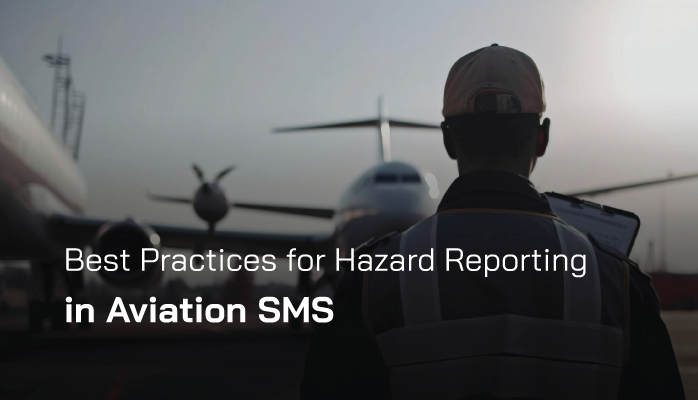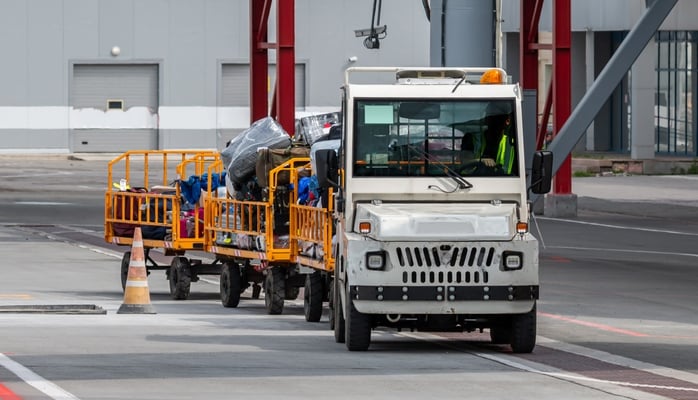What Are Goals for Best Practices of Hazard Reporting

Knowing best practices for hazard reporting in aviation safety management systems (SMS) is an attempt to better attain the goals of hazard reporting.
What are the goals of hazard reporting?
There are three main objectives:
- Gather data;
- Use that date to improve the SMS; and
- Improve safety culture.
Best practices for hazard reporting are loose guidelines that drive these objectives. Hazard reporting is the basis of your SMS performance. Best practices are how you can design your SMS to maximize this performance.
Related Articles on Hazard Reporting in Aviation SMS
- What Good Hazard Reporting Process Look Like in Mature Aviation SMS
- What Are Most Important Things to Know About Hazard Reporting in SMS
- What Is Missing Most in Aviation Hazard Reporting Systems?
We see a lot of mistakes made that give negative incentives for hazard reporting. We offer the following five important questions and answers for best practices for hazard reporting in your SMS.
What Concerns Should Employees Report
This question is of utmost importance. It’s a best practice that we see where most opportunities are lost. In short, many organizations only encourage their employees to report very clear safety concerns.
The mistake organizations make regarding this question is that they don’t encourage reporting all concerns because:
- Safety managers don’t want to be overloaded with reports; and
- Safety professionals don’t see the benefit of reporting even very minor concerns.
However, for every:
- One serious incident;
- There are 59 minor incidents; and
- 600 seemingly negligible incidents or “conditions.”
Here’s the best practice:
Your reporting guidelines should encourage employees to report ALL safety issues, even if they only seem like inconsequential conditions.
Hazard Reporting Should Include All Close Calls

If employees don’t report minor incidents and conditions, your SMS is simply allowing minor incidents to happen. Many minor incidents can be prevented if you are managing the conditions that lead to those incidents. We touch on the many minor incidents, but what we should spell out for you is that these 600 negligible incidents or close calls are the practice you need to prevent "The Accident."
Those 600 close calls provide considerable opportunities for the SMS to develop and refine risk controls that very well could avert "The Accident." When management neglects to see the value of reporting EVERY close call, they are complicit in allowing "The Accident" to occur. This becomes a tragedy that could be avoided.
A properly designed and performing SMS is the solution to avoid "The Accident." It is the management's responsibility to capitalize on every opportunity to prepare for and avoid "The Accident."
What types of issues do you want employees to report?
Do you have a hazard reporting policy that outlines which types of issues should be reported?
We often see that management is only interested in capturing safety-related events and potential hazards. This is a shortsighted attitude, especially when one considers the potential of the aviation SMS to be extended to other areas of operational concerns, such as
- Security;
- Environmental;
- HR; and
- Quality.
Management is investing considerable sums into implementing "required" aviation SMS. The tragedy I see every day is the wasted opportunity to use these tools for cross-purposes and maximize the return on investment.
Best practices will have management:
- Encourage employees to report ALL close calls and minor incidents; and
- Focus on capturing data that can improve operations by using the same SMS processes, but that focus on other operational areas, such as security and quality.
There is a growing number of safety professionals who recognize this opportunity to maximize the utility of SMS processes, especially in the area of quality management systems (QMS). For the past ten years, we have been working on educating safety professionals about this missed opportunity of integrating safety and quality management systems.
The biggest drawback to integrating safety and quality management systems is the apprehension safety teams face when opening up their "safety program" to include the quality departments. Yet, I think there is another fear. SMS has been developing standards, and an SMS is audited per those standards and expectations of what an SMS means and what an SMS looks like. When aviation service providers start implementing hybrid QMS and SMS, these hybrid systems become more difficult to audit per established SMS protocols.
This is definitely a business decision, but if you have an opportunity to implement both quality and safety into the same system, you will realize economic efficiencies by either:
- reducing a system; or
- bringing more focus on operational quality at the same time you manage aviation SMS requirements.
Related Articles on Integrating QMS and Aviation SMS
- What Are Differences of Aviation Safety Management Systems (SMS) and QMS
- Moving From Quality Management to Integrated SMS and QMS Systems
- 5 Easy Ways to Combine QMS and SMS in Aviation Operations
How to Design Hazard Reporting Forms
Another common mistake companies make regarding hazard reporting is with the design of their hazard reporting forms.
The common mistakes are:
- Hazard reporting forms are too long
- Who wants to spend 10 minutes filling out a form?
- Hazard reporting forms don’t have enough form fields
- Safety managers have to constantly follow up with reporters to acquire more information
- Only one generic hazard reporting form
- How can you capture relevant, operational-specific data?
Here’s the best practice:
- Have multiple reporting forms (3-5 should satisfy most organizations) to capture different types of issues;
- Keep hazard reporting forms as short as possible while still capturing needed information; and
- Get feedback from employees about how satisfied they are with the hazard reporting forms.
Point number three is especially important and is a best practice that most SMS do not employ. However, considering that employees are the people submitting your issues, you should design your forms around their preferences as much as is feasible.
When employees find hazard reporting processes frustrating or too cumbersome, I predict you may get one report from each employee if you are lucky. For those employees who patiently suffer through your long reporting forms, they may do it once but don't expect repeat behavior. Filling out long, cramped, overly detailed hazard reporting forms is about as fun as standing in line at the phone company trying to change your phone plan. I dread the thought.
In short, adapt flexible hazard reporting forms without too many required fields. You want THE REPORT! Any friction to reduce getting these reports reduces your level of safety and ability to improve your processes that reduce risk to as low as reasonably practical (ALARP).
You may have a safety reporting system that also allows employees to submit security, quality, or environmental concerns. This is a best practice for realizing the full benefits of an aviation SMS. For these specialty reports, you have to consider the audience using these forms. Is the terminology in layman's terms? Or do you need to be a security specialist to understand what management wants to report?
Keep it simple! If you haven't captured this most important point, reduce friction for employees to submit hazard reports.
Related Articles on Aviation Hazard Reporting Systems
- How to Develop a Hazard Reporting System in Aviation SMS [With Free Checklist]
- Examples of Good Hazard Reporting Forms in Aviation Safety
- How to Make Effective Hazard Reporting Forms for Aviation SMS
How to Offer Guidance for Hazard Reporting
Guidance for hazard reporting is not complex. In fact, the more straightforward the guidance, the better.
The four best pieces of guidance for hazard reporting you can offer your company are:
- Provide lots of hazard identification training;
- Assess hazard identification knowledge;
- Have a very simple hazard reporting process (a stranger should be able to do it); and
- Have a chart of preferred types of issues to report.
Following these guidelines is a fantastic way to ensure that employees recognize what to report, and know how to report it.
Another best practice is to have hazard reporting guidelines easily accessible to all employees. Personally, I believe the best place for this important safety information is a separate tab in your online hazard reporting system. This allows employees to review reporting guidelines at any time during the hazard reporting process.
If you can't have a separate "tab" in your online hazard reporting system, the next best alternative is to have a link that directs the employee to this guidance, whether the guidance is:
- Another Web page in your hazard reporting system; or
- A link to PDF guidance that can be downloaded and reviewed at the employee's convenience.
How to Improve Safety Reporting Culture

Safety reporting, as said, is the foundation of your SMS performance. Many organizations struggle with:
- Having a good safety reporting culture;
- Understanding how to improve safety reporting culture; and
- Actually improving their safety reporting culture.
Fortunately, improving safety reporting is not as challenging as improving the overall safety reporting culture. Improving hazard reporting culture simply involves targeted activities related to safety reporting.
This can be done in a 5-step process:
- Offer guidance for hazard reporting (see previous section);
- Give direct feedback to reporters on as many reported issues as possible;
- Allow employees to monitor actions taken on their own reported safety issues;
- Include employee’s hazard reporting statistics in his/her performance review; and
- Create, distribute, and constantly reinforce your non-punitive reporting process.
Additionally, you may want to point out top hazard reporters with charts or mention them in safety newsletters. Many safety promotion activities help improve safety reporting cultures. The great thing about these safety promotion activities is that they don't cost much. The downside is that you must be consistent and you often don't see an immediate return on investment. Improving your safety reporting culture is a long-term project that carries some risk.
What is the risk of promoting the safety reporting processes at your organization? How about this scenario? ACME Airlines budgeted $16,000 to:
- Conduct safety surveys;
- Create four quarterly safety newsletters; and
- Hold two hazard identification training courses.
Just as employees were accepting the new way of doing business using the new SMS, the safety champion, who also was the safety manager spearheading this safety promotion campaign became disillusioned with management and suddenly left the company. A new safety manager comes into the company and there is no successful transition from the former safety manager to the replacement. Two years go by and management realizes that their hazard reporting culture has stagnated.
In the previous example, the $16,000 sunk cost of the SMS can be considered almost a complete loss.
How many times have you seen this happen? I see this happen to aviation service providers between 3-5 times per year. I don't want to single out a particular region for this, but based on a dozen years of empirical evidence, African and Middle Eastern companies will experience this at twice the rate of Canadian, Australian, and U.S.-based companies. The reason for this heightened risk is the lack of oversight and involvement by top management. There appears to be less involvement of top management SMS in African and Middle Eastern companies. Unfortunately, their aviation SMS is subjected to a higher risk of failure.
The point here is that safety culture is like an SMS implementation: it is a top-down approach. Effective hazard reporting cultures require top management commitment and EXPLICIT participation and support.
Related Articles on Aviation Hazard Reporting Culture
- Indicators of Good Hazard Reporting Culture
- Aviation Safety Chart: Monitoring Hazard Reporting Culture
- Essential KPIs for Poor Hazard Reporting Cultures in Aviation SMS - With Free KPI Resources
What Are Good Incentives for Hazard Reporting
Sometimes, simply creating an environment with good reporting incentives is all it takes to develop high-quality hazard reporting cultures.
Many of these incentives are a recap of things we have already covered:
- Non-punitive reporting policy that is reinforced;
- Clear action taken on reported safety issues, including direct feedback;
- A reporting process that is so easy a stranger could easily do it;
- Have many different ways to report safety issues, such as via email, cell phone, tablet, etc.;
- Include multiple reporting forms that are short and relevant;
- Constant encouragement for reporting, such as via daily messages, email, newsletters, etc.; and
- Clear guidance on hazard reporting expectations.
All of these bullet points can be incorporated into the design of your SMS and adopted early on in SMS implementation.
For more information about this, see our awesome pamphlet that you can distribute in your organization to encourage hazard reporting best practices.
A best practice is to have your hazard reporting system integrated with the risk management system. When aviation service providers have more than 100 employees, having too many disparate systems in your SMS that store SMS documentation becomes too much of a risk. There are too many failure points. An integrated SMS database reduces risk and improves SMS process efficiency.
If you need help with your SMS hazard reporting system or other SMS tools, we can help.
These videos will provide an overview of a complete SMS database solution that can manage ALL SMS requirements and not just a handful.
Last updated October 2025.






